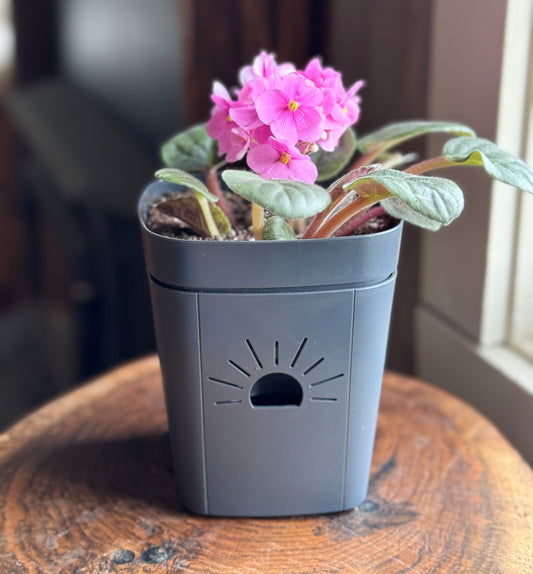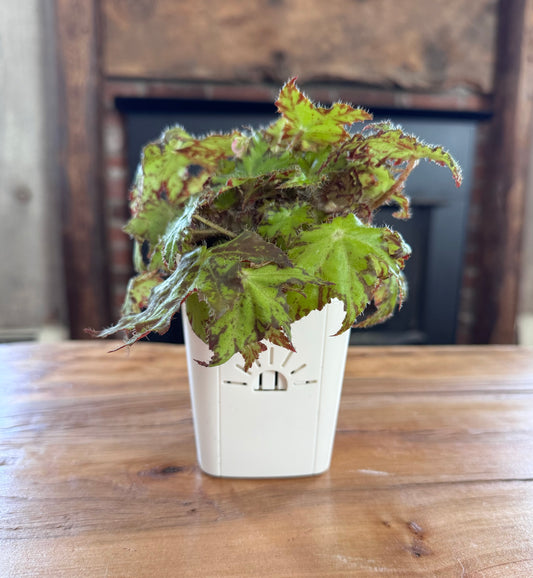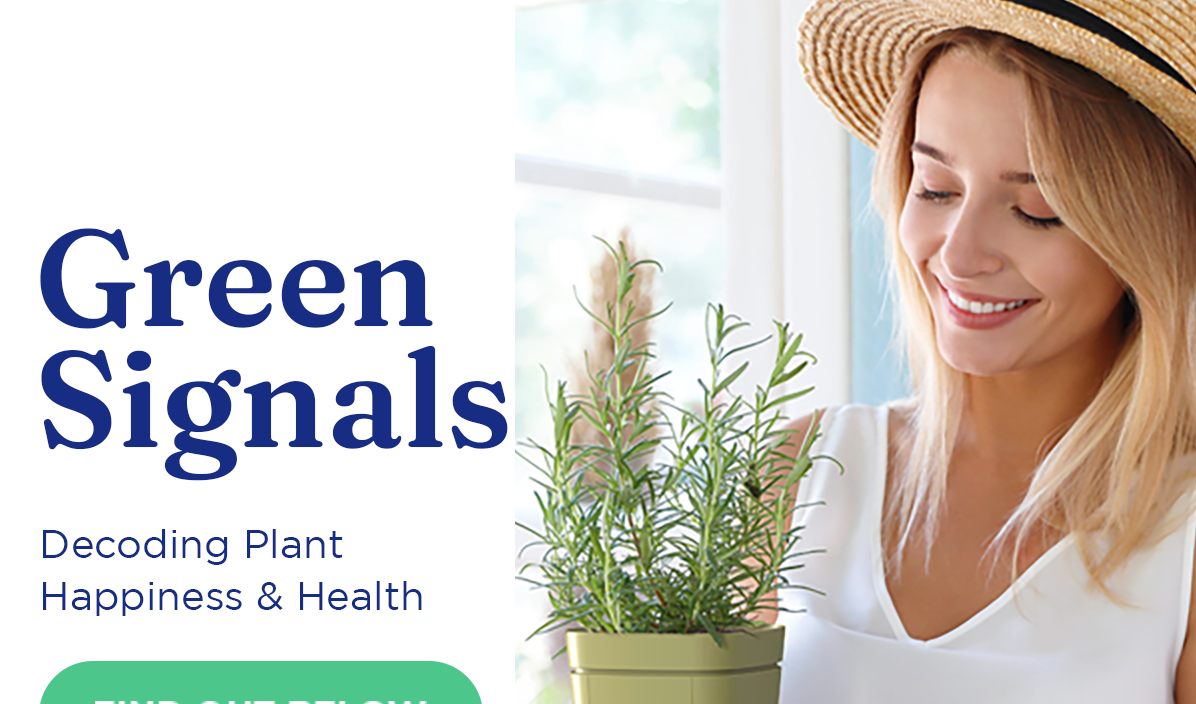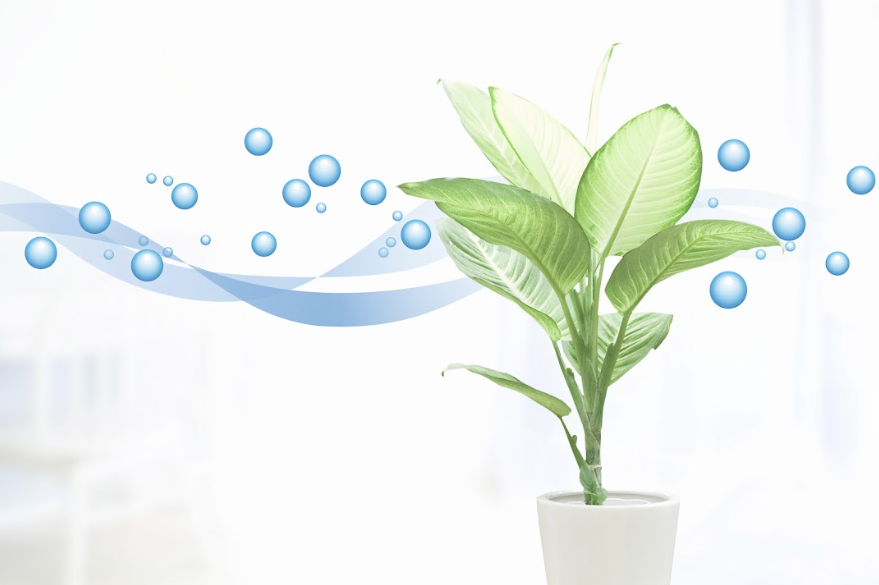Light
Requirements
In order to ensure your palm remains healthy, it is important to provide the appropriate amount of light. Most palms need bright, indirect light and can easily grow in rooms with plenty of natural sunlight. However, some species may be able to tolerate lower light conditions but will not produce new leaves as vigorously under these circumstances. If you are unsure what kind of lighting your particular palm needs, consulting a local nursery expert can help you determine the right amount for your plant’s needs. Additionally, if you find that the area where you have placed your palm is too dark, try supplementing its environment with a few LED lights designed specifically for indoor plants. With proper care and attention, most palms will thrive in any home!
Water Requirements
If using a Naked Root planter, you can water your palm on a 7, 14, or 21-day schedule, depending on the variety. We have included notes on the individual varieties below.
For those using a conventional planter, aim to allow the top 1 inch of soil to dry out between waterings and then provide a thorough drench. Many palms come from tropical places and grow directly in sandy soil, so overly moist or waterlogged soil will rot them. Other palms are understory plants in rich, moist humus under tropical trees and require evenly moist soil that is never soggy.
Genus Summary
| GENUS | Palm |
| COMMON NAMES | Fishtail palm, Banana palm. |
| LIGHT | Bright, indirect light |
| WATER SCHEDULE | Naked Root = 7-14-21 depending on palm type |
| WATER REQUIREMENTS | Most require evenly moist soil that is not soggy. A few like to dry between watering. |
| HUMIDITY | Average humidity over 50 percent. A few species like humidity over 70 percent. |
| TEMPERATURE | 60-80°F |
| FEEDING | 1x month |
| TOXICITY | Majesty Palm, Parlor Palm, Cascade Palm, Sago Palm, and Areca Palms are toxic to animals and humans. |
| PESTS | Spider mites, aphids. |
| DISEASES | Root rot. |
| POT | Maximum aeration and drainage. |
| SOIL | Commercial mix made for palms. |
| FERTILIZER | 8-2-12 with micronutrients twice per year |
| PROPAGATION | By division or seed |
| PRUNING | By division or seed |
| SIZE | Two to twenty feet indoors |
Humidity
Most palms do well in medium humidity, over 50 percent. A humidifier is never a bad idea, as this can help combat spider mites, which love dry air. A few species, such as Majesty Palms, like high humidity of over 70 percent.
Temperature
When caring for houseplant palms, keep in mind the temperature that they prefer. Most indoor palms should be kept at temperatures between 65-80°F, as this range allows them to thrive and produce healthy growth. While some varieties of palm are hardier than others, research should still be conducted prior to exposing your plant to temperatures below 50°F in order to prevent any potential damage from cold weather.
To ensure optimal growing conditions for your palm plants, make sure you protect them from drafts near doors and windows as well as air conditioning vents which can cause sudden drops in temperature. Generally speaking, most species of houseplant palms will benefit from warm temperatures with an ideal nighttime temperature of 60-65 °F and daytime temps ranging between 70-80°F.
Toxicity
Toxicity levels vary among the various palms grown as indoor houseplants. Some are highly toxic, and some are entirely edible. Research the particular variety that you have before placing it near children or pets. Majesty Palm, Parlor Palm, Cascade Palm, Sago Palm, and Areca Palms are toxic to animals and humans.
Pests and Diseases
Spider mites and scale insects are two of the most common pests that threaten palm varieties. These pests can cause damage to the plant’s leaves, resulting in discoloration, yellowing, or scarring. To prevent these problems from occurring, ensure that a palm has adequate humidity levels and all the essential nutrients needed for growth and health.
Additionally, correct potting soil should be used for adequate drainage and aeration as this reduces the risk of root rot which can also have devastating effects on a palm tree if not properly managed. Be sure to select pots with appropriate root zone aeration and regularly check the drainage holes for any blockages caused by debris, such as dead leaves or dirt.
Pot
When choosing a pot for your palm, try to find one that is well-aerated. Oxygen levels in the soil are critical in helping palms thrive and reach their full potential. Additionally, it shouldn’t hold too much water as this can lead to root rot which will kill the plant over time. Finally, ensure your pot has ample holes at the base so excess water can escape easily while oxygen enters freely through them into the roots below. With these simple steps, you’ll soon have a happy, healthy palm!
Soil
When selecting soil for your palm plants, ensure that the mixture is loose and porous. The best combination of soil will include a mix of peat moss, leaf mold, and shredded bark. This allows the plant to receive adequate drainage while still providing enough nutrients for growth. You can also buy pre-made cactus or palm soil mixtures specifically designed for growing palm plants if you don’t want to make your own mixture at home. When planting palms in containers indoors, be sure to use a potting mix that doesn’t contain too much organic material, as this can cause root rot over time due to a lack of air circulation in the container. It is also important that you water your palms regularly but not too frequently, as overwatering can lead to root rot and other issues with your plant’s health.
Fertilizer
When fertilizing, be sure to use a slow-release palm fertilizer with an analysis like 12-4-12 or 8-2-12. It is important that the fertilizer contains essential micronutrients such as iron, manganese, zinc, boron, and copper in order to keep your plant healthy. Fertilize only two to three times per year during the spring and summer months when the palm is actively growing. Be careful not to over-fertilize. Too much fertilizer can cause the burning of leaves and damage your plant’s roots.
Propagation
When propagating palms, home gardeners have two main options. The first is to separate offshoots from the parent plant and replant them in a new pot. This method requires minimal effort but can take some time before any visible growth occurs.
Alternatively, you may choose to germinate seeds. These are easily obtained from online retailers and are easy to germinate if you follow the instructions precisely. When planting palm seeds, be sure to use sterile soil and keep them sufficiently moist until they germinate – this usually takes around two weeks for most species. Once your seedlings have grown large enough, transfer them into larger containers.
Pruning
Pruning palm trees should be done sparingly and with care. When pruning your palms, you should only trim off any brown or dead foliage that is present. It’s important not to over-prune, as this can cause stress on the tree, which may lead to disease or insect infestations. If there are multiple brown fronds clustered together, it’s best to remove them all at once rather than singling out individual fronds for removal. Additionally, avoid cutting into the green parts of a leaf, as this can cause unnecessary damage to the plant and lead to more problems down the line. Pruning should always be done with clean shears in order to reduce the risk of spreading disease from one plant to another. By following these simple steps when pruning your palms, you will ensure that they stay healthy and beautiful for decades!
10 Striking Varieties and Cultivars
Palm plants bring a special feeling of tranquility to indoor spaces, and they can be a great addition to your home if you can provide the right conditions. Here are a few of our favorite indoor palm varieties.
Livistona chinensis – Chinese Fan Palm – Livistona chinensis, or Chinese fan palms, are an attractive and unique choice for indoor plants. Their star-shaped leaves set them apart from other palms with more traditional feathery fronds. They may be slow to grow. However, their mature height can reach 15 feet or greater. If you plan on growing the palm indoors, it is best to seek out the subglobosa dwarf cultivar that stays smaller in size. Chinese fan palms do well in bright light, but younger plants can handle shady locations as they become accustomed to their environment. It’s important to choose a larger pot due to the long taproot these palms produce. This helps ensure adequate room for growth over time. Water when the soil feels dry on top, and feed your Chinese fan palm once a year in springtime using a slow-release fertilizer specifically formulated for palm trees. With proper care and attention, Livistona chinensis make beautiful houseplants that enhance any home’s decor while also providing clean air benefits too!
Dypsis lutescens – Areca Palm – The areca palm (also called bamboo palm) is a popular choice for indoor houseplants due to its tolerance of low light, making it one of the easiest palms to grow indoors. Its large, feathery green fronds have a gentle curve and contrast against the yellow-green stems. When caring for an areca palm, use fertile soil and give it adequate water as needed. A monthly fertilizer application can help maintain a lush look and promote healthy growth. With proper care, an areca palm will make an attractive addition to any home or office environment. This variety is toxic to animals and humans.
Ravenea rivularis – Majesty Palm – The majesty palm is a great option for growing thanks to its shade tolerance and slow growth rate indoors. However, it does need more care than other palms. You must keep the humidity and moisture levels high in order to ensure proper development. If your home does not have areas that are naturally humid or moist enough, you can create them with a humidifier or mister. Additionally, as this palm grows quite large over time, it may eventually outgrow its indoor space – so be prepared to consider repotting into a larger container or moving outside periodically if needed. Despite these extra needs, cultivating an indoor majesty palm is well worth the effort – when given the proper conditions, this dark green beauty will bring fresh life and energy into any room of your home! If using a Naked Root planter, follow a 7-day watering schedule for a Majesty Palm. This variety is toxic to animals and humans.
Chamaedorea cataractarum – Cascade Palm – Cascade palms can be grown indoors with ease due to their love of moist soil and low-light conditions. The plant is extremely full, with clumps of fronds reaching up to 6 feet in height when mature. You’ll be able to separate the clumps, giving you new plant material for propagation by division. When growing a cascade palm indoors, it’s important that you give it frequent irrigation since its native habitat consists of streams and wet lowlands. Due to their need for filtered, indirect light, cascade palms make excellent indoor houseplants. Those using Naked Root planter pots should follow a 7-day watering schedule in order to properly care for the Cascade Palm. This variety is toxic to animals and humans.
Chamaedorea elegans – Parlor Palm – The parlor palm (Chamaedorea elegans) is a great choice for those looking to grow an indoor palm. It requires minimal care and can tolerate average levels of light and room temperatures. However, it thrives in higher-than-average humidity, as dry conditions will attract spider mites. To maintain the soil moisture level, water your parlor palm regularly but not excessively – the ideal amount should be about as wet as a squeezed-out sponge. If you are using a Naked Root planter for your parlor palm, then make sure to stick to a 7-day watering schedule for the best results. Furthermore, pruning is rarely necessary with this plant; only dead branches need to be removed occasionally. Be advised that fully direct sunlight will burn this plant. This variety is toxic to animals and humans.
Beaucarnea recurvata – Ponytail Palm – The ponytail palm (Beaucarnea recurvata) is a popular and easily identifiable indoor plant due to its short, sturdy trunk and gracefully arching leaves. It’s important to remember that this plant is not actually a true palm—it’s actually a succulent! The swollen base of the trunk serves an important purpose—it functions as a water reservoir for the plant, making it very drought-tolerant. For optimal health, give your ponytail palm plenty of sunlight. It can tolerate direct sun in the morning but should be given indirect bright light in the afternoon. If you are growing your ponytail palms in Naked Root pots, follow a 21-day watering schedule to ensure proper hydration levels for healthy growth. Additionally, pot-bound plants will help keep tabletop specimens more manageable.
Cycas revoluta – Sago Palm – The sago palm is a great plant for those just starting out with indoor palms. Its fronds grow in an upright habit from a short, shaggy trunk that looks similar to a pineapple. Despite its name, it is not actually related to true palm trees and grows very slowly over time. In order to ensure the best growth of your sago palm, you should choose an indoor location that receives filtered sunlight for four to six hours per day. This variety also needs regular and consistent moisture, but make sure not to overwater – the soil surface should be nearly dry between water applications. For optimal health, aim for a 14-day watering schedule when using Naked Root planter pots! This variety is toxic to both humans and animals.
Yucca elephantipes – Yucca Palm – When it comes to indoor yucca palms, it is essential to identify them correctly. Yucca aloifolia, also known as the Spanish bayonet, has sharp leaves and should not be kept indoors because of its potential to cause injury. The spineless yucca palm (Yucca elephantipes), on the other hand, can be grown indoors without worry. While its leaves have a pointy tip, they are unlikely to draw blood like its spiny cousin. It may also be referred to as “stick yucca” when sold in stores. This plant has tough strappy green leaves that emerge from an attractive trunk-like stem and are very drought tolerant and able to grow in full sun or part shade environments. It is recommended you follow a 14-day watering schedule for Naked Root Plants.
Caryota mitis – Fishtail Palm – Fishtail Palms are a unique addition to any home and can be quite the conversation piece due to their leaf shape and towering size. But as with any indoor palm, they require proper care in order to thrive. Fishtails need plenty of intense light. If leaves start getting spotted, it’s likely a sign that your plant needs more sunshine! Additionally, if you notice magnesium deficits, you can help by regularly giving them Epsom salts treatments. When young, these palms should be repotted, but once they reach full maturity (usually up to 20 feet tall), the weight and size will make this impossible. Lastly, watch out for insect infestations–aphids, mealybugs, and whiteflies are common culprits when it comes to fishtail palm pests, so regularly check for signs of an outbreak and treat them accordingly. In a Naked Root planter, use a 14-day watering schedule.
Pinanga coronata – Ivory Cane Palm – The Ivory Cane Palm (also called Kuhl’s Palm) is a unique and beautiful species with a distinctive swollen crown shaft that is bigger than the stem. As the plant matures, this crown shaft will turn green or reddish green. The leaves grow out of the shaft bright green and up to 10 inches long. In its natural habitat, it can grow up to 20 feet tall, but when kept in containers, it tops out at around 12 feet – making it much more suitable for indoor settings. From late winter through early spring, small pink blooms appear on the foliage, which eventually matures to red before forming purple berries. This palm prefers bright indirect light and does well in average indoor lighting. Keep your Ivory Cane Palm in a smaller pot if you wish to keep it at its current size – otherwise, repot every few years as necessary. Those growing in a Naked Root pot can follow a 14-day watering schedule to ensure optimal health and growth.
Summary of Palm Plant Care
Most indoor palm plants do well in bright indirect sunlight, medium humidity, and moderately moist soil. Provide fertilizer twice per year and trim off any dead leaves as necessary. Be sure to research toxicity if you have children or pets, as some varieties are toxic. Keep indoor temperatures between 60-80 degrees Fahrenheit and regularly inspect for pests.





 Verified Buyer
Verified Buyer









